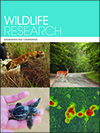This month’s Special Issue is focused on the problem of invasive species and their control. Invasive species can cause a wide variety of problems but, here, the main focus is on species with potential to harm the environment. The papers address methods for the effective control of a range of vertebrate and invertebrate species, as well as the vexed issue of monitoring those species even at the low abundances that result from eradication programmes.

Wildlife Research
Volume 50 Number 5 2023
Special IssueControl and monitoring of invasive species
WR21123Feral cat GPS tracking and simulation models to improve the conservation management of night parrots

Night parrots are one of Australia’s most endangered birds, in part due to feral cats. This study aims to understand feral cat habitat selection around night parrots, then estimate effectiveness of possible management actions. Using GPS movement data from feral cats, we identified their preferred habitats and how effective different control options would be using simulation models. Photograph by Stephen Murphy.
WR21123 Abstract | WR21123 Full Text | WR21123PDF (1.3 MB) | WR21123Supplementary Material (315 KB) Open Access Article
WR22009Improved house mouse control in the field with a higher dose zinc phosphide bait
 , Peter R. Brown
, Peter R. Brown  , Lyn A. Hinds
, Lyn A. Hinds  , Steve Henry, Nikki Van de Weyer
, Steve Henry, Nikki Van de Weyer  , Freya Robinson, Kevin Oh and Richard P. Duncan
, Freya Robinson, Kevin Oh and Richard P. Duncan 

Recent studies have shown that the tolerance of wild house mice to zinc phosphide (ZnP) in Australia is significantly higher than previously assumed, which may account for the reported variability in efficacy of ZnP baits used for house mice control in grain-growing regions. We used a BACI design to show that a newly derived ZnP50 bait is more effective under field conditions than the is currently registered ZnP bait in reducing populations of house mice during a mouse outbreak. Photograph by Nikki Van de Weyer.
WR22009 Abstract | WR22009 Full Text | WR22009PDF (1.1 MB) | WR22009Supplementary Material (394 KB) Open Access Article

The success of aerial rodent eradications relies on spreading toxic bait into every rodent territory. Bait must then remain available long enough for rodents to find and consume a lethal dose. This study assessed the unexpected interference by non-native slugs during the mouse eradication attempt on Gough Island, and found that bait consumption by slugs was concerningly high. We describe our attempt to manage the issue by adjusting the baiting strategy. Photograph by Araceli Samaniego.
WR22024 Abstract | WR22024 Full Text | WR22024PDF (4.3 MB) | WR22024Supplementary Material (860 KB) Open Access Article
WR21175Is the Felixer cat control device safe for marsupial carnivores?
 , John L. Read, Chris N. Johnson, Menna E. Jones, Matthew D. Pauza, Joss Bentley, Andry Sculthorpe, Morgan Humphrey and Rowena Hamer
, John L. Read, Chris N. Johnson, Menna E. Jones, Matthew D. Pauza, Joss Bentley, Andry Sculthorpe, Morgan Humphrey and Rowena Hamer 

Feral cats present an alarming threat to Australia’s native biodiversity. The Felixer grooming device is a method of feral cat control that is designed to be target-specific and efficient in the control of this invasive species. In order for the Felixer to be considered as a feral cat control device in Tasmania, its effectiveness in differentiating cats from similar carnivores, specifically Tasmanian devils and quolls, needs to be tested. Photograph by Darren Rumble.
WR21175 Abstract | WR21175 Full Text | WR21175PDF (1.1 MB) Open Access Article

Foxes threaten the survival of many Australian wildlife species, yet little is known about their population numbers. We monitored a fox population for four consecutive years and compared a variety of monitoring methods and analytical techniques. Our findings will help land managers design fit-for-purpose monitoring programs to better understand the threat posed by foxes and the efficacy of efforts to manage their populations. Photograph by Andrew Carter.
WR22017 Abstract | WR22017 Full Text | WR22017PDF (1.2 MB) | WR22017Supplementary Material (594 KB) Open Access Article
WR22103Detections of house mice on Gough Island approach zero within days of aerial baiting

How quickly house mice succumb after aerial baiting on islands is not well understood. We used trail cameras to assess mouse activity before and after an aerial mouse eradication operation on a temperate island, and found a dramatic population collapse within 3 days and almost zero activity after 7 days. We discuss the value of camera monitoring to inform eradication strategies and to confirm eradication outcome. Photograph by RSPB.
WR22103 Abstract | WR22103 Full Text | WR22103PDF (2.4 MB) | WR22103Supplementary Material (707 KB) Open Access Article
WR22097Recounting bias can affect abundance estimates from intensive helicopter surveys of feral goats

The possibility of recounting animals during helicopter surveys of wildlife is rarely investigated. Using simultaneous ground observers, we investigated the movements of feral goats in response to intensive helicopter surveys. Goats moved away from already flown transects more frequently than towards those transects, which is likely to have resulted in recounting and consequent overestimation of population size. We make design recommendations to overcome this issue. Photograph by Peter Fleming.
WR22097 Abstract | WR22097 Full Text | WR22097PDF (540 KB) Open Access Article

Effective detection is critical for invasive species monitoring to assess progress of control and eradication. We assessed the influence of vegetation types, seasons and inter-specific interactions on the detectability of Pacific rats by using tracking tunnels, live-traps, chew cards and trail cameras. We recommend the use of camera trapping for rodents at low density and under high predator disturbance because it has the highest number of detections under all scenarios. Photograph by camera trap.



